 |
| The Independent Traveler's Newsletter PAGE THREE |
 |
| The Independent Traveler's Newsletter PAGE THREE |
| A Visit to
Occitanie & the Pyrénées . . . Ariège continued The Ariège is a refuge for many: city dwellers who have had enough of the pressures of life, a dwindling population that operates bed and breakfasts or breeds mohair goats, and anyone who wants to 'get away from it all'. 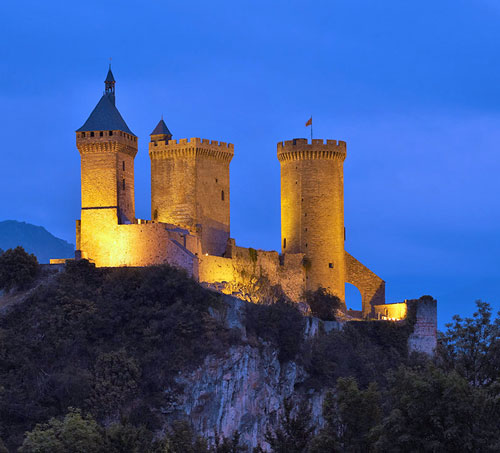 Foix is the
principal city, located between the rivers
Ariège and Arget. Historically, the Counts of Foix joined
forces with the Counts of Toulouse and Carcassonne to protect the
Cathars against the French invading from the north. The region of
Béarn, to the west of the Hautes-Pyrénées département, was inherited
through marriage in 1290, and by the fourteenth century Foix had lost
its glory when the Counts decided to move to Béarn. It wasn't
until the French Revolution that Foix regained its standing when it was
named the capital of one of those new designations: a département. It became
09, the Ariège. Foix is the
principal city, located between the rivers
Ariège and Arget. Historically, the Counts of Foix joined
forces with the Counts of Toulouse and Carcassonne to protect the
Cathars against the French invading from the north. The region of
Béarn, to the west of the Hautes-Pyrénées département, was inherited
through marriage in 1290, and by the fourteenth century Foix had lost
its glory when the Counts decided to move to Béarn. It wasn't
until the French Revolution that Foix regained its standing when it was
named the capital of one of those new designations: a département. It became
09, the Ariège.The city has a wonderful old town, a delightful market square and a fine church, St-Volusien. And, within the walls of the castle you will find a significant prehistoric collection in its Musée Départemental du Château de Foix, including the most complete mammoth skeleton found in southern France. It also contains pre-Roman and Roman altars, prehistoric reindeer and bears as well as other findings from the nearby Ariège caves. Montségur, known as the 'Cathars' last stand', or the 'Alamo' of the Ariège, is a small village with its spectacular castle ~ actually the ruins of the razed Cathar stronghold ~ looming high above [photo at right]. This represents the culmination of the Cathar defense against the Crusade that destroyed them. Having lived in peace with Catholics for a very long time, the Cathars were suddenly the object of both the Church and the King to be destroyed before their ideas spread. Today's inhabitants still prefer their own ways and are reviving their Occitan dialect as they simultaneously forge a relationship with the Catalans across the border in Spain. Some consider this the eastern version of the relationship between the the French and Spanish Basques along the Atlantic coast. The earliest signs of human settlement date back to the stone age about 80,000 years ago. Evidence of Roman occupation, such as currency and tools, have also been found in and around the site. Unlike the word 'aix' (aquae) as in Aix-en-Provence, the word 'ax' in Ax-les-Thermes does not refer to the springs. Instead, due to the extremely high sulphur content, 'ax' means 'stink'. Oh, the springs do exist, bubbling out of the ground at 77 degrees Centigrade. They have been used for heating since the mid-1200s when King Louis constructed a hospital in the town for his Crusaders who contracted leprosy in the Holy Land. The spa at Ax-les-Thermes has recently been refurbished and the city is popular as a base for skiing and hiking in the highest mountains of Ariège. 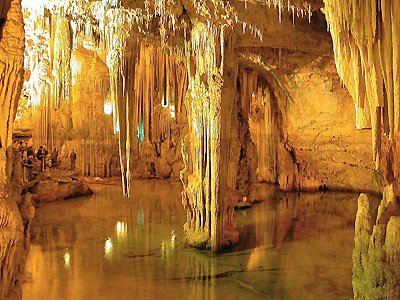 Near Tarascon-sur-Ariège one will find the Parc Pyrénéen de
l'Art Préhistorique with its replicas of the paintings
found in Grotte de Niaux.
Nearby, is the Grotte de
Bédeilhac that was
discovered in the 18th century. But, only in 1906 did Henri
Breuil discover the Paleolithic art inside of bison, deer, horses,
goats and mysterious symbols left behind by its Magdalenian
inhabitants. The cave was subsequently lived in until the Iron
Age and a skeleton of a Neolilthic man between 30 and 40 years of age
was found near its entrance. Even larger is Grotte de Lombrives [photo
right], the biggest cave in Europe open to the public.
Located on the N20 a few kilometers from Tarascon, visits are conducted
by a small train, allowing only a portion of the cave to be seen.
There are stalactites and stalagmites, and the cave is said to be
connected to Niaux with subterranean links. It has upper
galleries some 150 feet above the floor accessible by ladder. Not
too far away is Grotte de
Bethléem, thought to have been used by the Cathars for
some ritualistic purposes. Near Tarascon-sur-Ariège one will find the Parc Pyrénéen de
l'Art Préhistorique with its replicas of the paintings
found in Grotte de Niaux.
Nearby, is the Grotte de
Bédeilhac that was
discovered in the 18th century. But, only in 1906 did Henri
Breuil discover the Paleolithic art inside of bison, deer, horses,
goats and mysterious symbols left behind by its Magdalenian
inhabitants. The cave was subsequently lived in until the Iron
Age and a skeleton of a Neolilthic man between 30 and 40 years of age
was found near its entrance. Even larger is Grotte de Lombrives [photo
right], the biggest cave in Europe open to the public.
Located on the N20 a few kilometers from Tarascon, visits are conducted
by a small train, allowing only a portion of the cave to be seen.
There are stalactites and stalagmites, and the cave is said to be
connected to Niaux with subterranean links. It has upper
galleries some 150 feet above the floor accessible by ladder. Not
too far away is Grotte de
Bethléem, thought to have been used by the Cathars for
some ritualistic purposes.The Grotte de Niaux, considered to contain the most beautiful prehistoric art in the caves of the Pyrénées and the best after the Dordogne's Lascaux, was also discovered in 1906 in the cliffs of the Cap de la Lesse. You approach it by a winding road. The Salle Noir, dating to 10,500 BC contains paintings of bison, horses (Basque ponies and the mérens) and mountain goats ~ all splendidly portrayed, making good use of the walls' contours. Also, the famous Niaux stag is here. The people who painted Niaux never lived in it, as they also did not live in Lascaux. However, in the Grotte de la Vache in nearby Alliat, paleontologists found stone walls built to divide living quarters some 13,000 years ago, flint tools and bones from family meals ~ but no art work. It is believed that this was a Magdelenian hunters' camp. 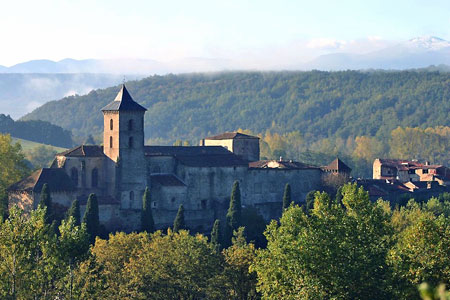 One of the Most Beautiful Villages of France is found in Ariège: Camon, along the D7 southeast of Mirepoix and southwest of Carcassonne. It has ramparts, an abbey and a château that has been converted to a very highly-rated and popular hotel [see photo left].  Location of the Ariège département Haute-Garonne  The Haute-Garonne is just to the west of Ariège, but you won't find too much written about it in guide books. You will find information about Toulouse, its large and bustling city, but that may be all. It is a largely rural area with minor rivers everywhere, such as the Salat, Seillonne, Marcaissonne, Lèze, Laure, Aussonnelle, Nère and perhaps a dozen others. Then there are the two major rivers flowing through the département: the Ariège and the larger Garonne. Finally, the Canal du Midi [photo below right] travels from the Aude département through the city of Toulouse emerging on the other side as the Canal Latéral à la Garonne which works its way westward alongside the River Garonne until just before the town of Langon in Aquitaine where it is finally swallowed up by the great river as it approaches Bordeaux. 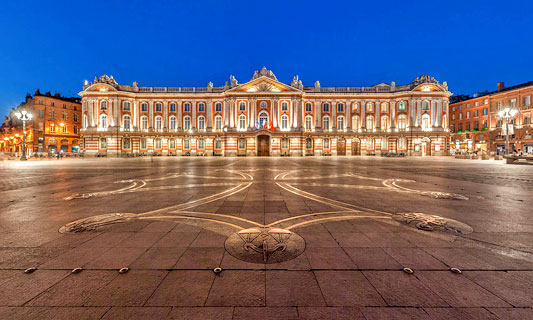 This is the façade of Capitole de Toulouse, the grand
building housing the
Toulouse City Hall, the Théâtre du Capitole de Toulouse opera company, the Orchestre National du Capitole de Toulouse, and the Salle des Illustres containing nineteenth century works of art. The Place du Capitole, in the foreground, was redesigned in 1995 with an Occitan cross by Raymond Moretti and is strictly reserved for pedestrians. 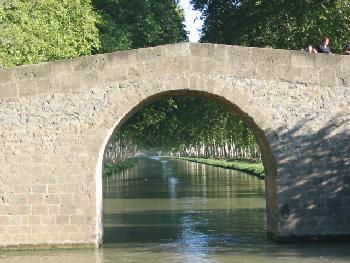 Toulouse
is France's sixth largest city and most famous for its aerospace
industry ~ it is the home of Airbus Industries. It has a major
university complex founded in 1229, and tourists always remember its
Old Town for the
rose-colored brick which makes it "Pink at dawn, red at noon, and mauve
at dusk". When exploring on foot, first visit the Old Town, head
for Place du Capitole and the 18th century Hôtel de Ville (city
hall). This is the neighborhood where you will find the greatest
concentration of sidewalk cafés and shops. Students are in
abundance, and it is said that their presence keeps prices down in the
local restaurants and stores.
The church, Les Jacobins, became the first convent of the Dominican sisters and was founded by Saint Dominic himself in 1216 to show resistance to local religious dissent. The University grew up around the convent, and the church is considered a Gothic masterpiece. The palm vaulting in the apse is its most celebrated feature. Worth visiting, the Gothic Chapelle St-Antonin contains frescoes of the Apocalypse from 1341 and relics of Saint Thomas Aquinas. In 1215, the Dominican order was born in Toulouse with a group of brothers led by Dominic de Guzman of Spain who was later canonized as Saint Dominic. The Dominican order, like the Franciscans, owns no property and these early Dominicans traveled in France and Italy on foot begging for their bread. Do visit the Basilique de St-Sernin, the largest Romanesque basilica in Europe, built to welcome the pilgrims passing through on their way to Santiago de Compostela in Spain. It has a famous 12th-century tower and beautiful 11th-century marble bas-reliefs of Christ. For museum buffs there is the Musée ds Augustins on rue de Metz with a fine collection of Romanesque art, a 14th-century Augustinian priory and 12th-century Romanesque capitals. Wander down to the Canal du Midi where you will find that, in France, people make good use of their rivers, lakes and canals for recreation not just for commerce. Houseboats moored along the edge of the canal remind us that Toulouse's industries are not all it offers. 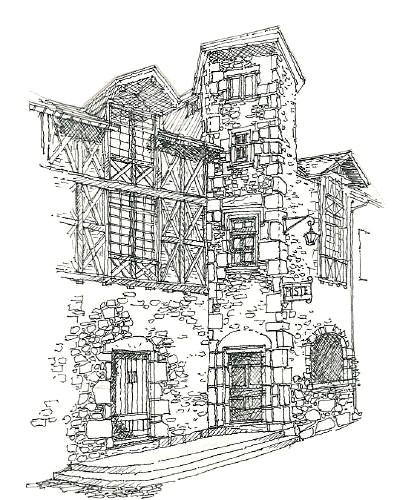 One of our favorite places in the Haute-Garonne is the Medieval hilltop town of St-Bertrand-des-Comminges. one of the Most Beautiful Villages of France [drawing left] in the ancient region known as the Comminges which is called 'the balcony of the Pyrénées'. The walk to the upper town, behind three gates, is not for the weak-kneed, but the views once you reach your destination are ample reward for your efforts. Seen from miles away, the grand 12th-century Cathedrale Ste-Marie dwarfs all other buildings in town. The cathedral has beautiful choir stalls built between 1523 and 1551 by craftsmen from Toulouse, the tomb of its founder, Bertrand de l'Isle, and the marble tomb of aristocrat Huges de Châtillon, who paid to complete the cathedral in the 14th century. As you are walking around the cathedral, don't miss a visit to the Romanesque cloisters displaying beautifully-carved capitals. Other streets are lined with timberframe houses dating from the twelfth to fourteenth centuries. At the southwest corner of the département, bordering the Hautes-Pyrénées, is the spa town of Bagnères-de-Luchon, reputed to be France's fourth or fifth largest spa town and attractive with its Belle Epoque architecture. Sporting enthusiasts who gravitate to the mountains in this region often use Luchon as their base. One guidebook describes its location as "set in a sunny amphitheatre on L'One River, surrounded by the highest peaks in the Pyrénées and a web of luscious emerald valleys." We couldn't have said it better. It has existed since the time of Tiberius in 25AD and was known as the Baths of Ilixo. It served as the hot springs for St-Bertrand-de-Comminges, attracting the rheumatic from throughout the Roman Empire, was decimated by various invaders and did not come back to life until the mid-1700s when the Baron d'Etigny felt it was time to restore it to its earlier glory. Taking the waters was once again in favor, and a road was built to make it more accessible. Cardinal Richelieu's nephew, a duke, was on of its first visitors, and his praise spread throughout Europe until everyone was was anyone showed up at Luchon's doorstep. Today, Allée d'Etigny is an elegant avenue with the rows of lime trees planted by its namesake, exclusive old hotels, fine shops and restaurants. Like Vichy in the Auvergne, this spa town maintains an air of aloofness and elegance reminiscent of the days when the famous and infamous came for "the cure". 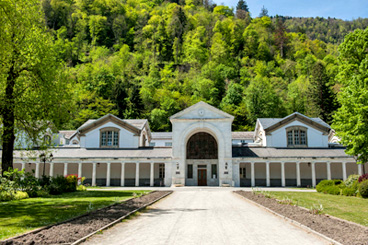 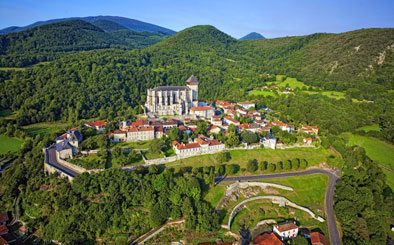
The Spa at Bagnères de
Luchon
Beautiful,
Medieval
St-Bertrand de Comminges
For anyone traveling to the
Pyrénées, it is worth remembering that they boast 360
days of sunshine every year ~ we've enjoyed many autumn days in this
region of France. Next:
The Hautes-Pyrénées.
continued
on page 4
|